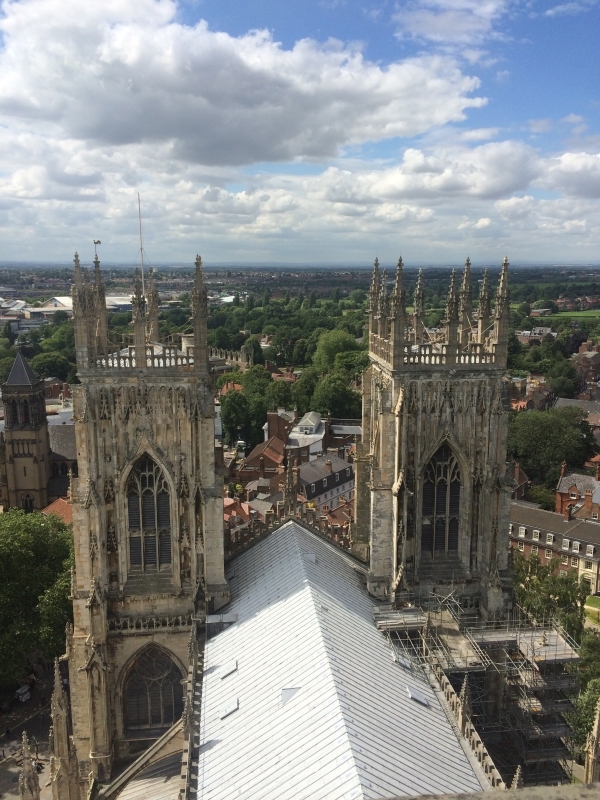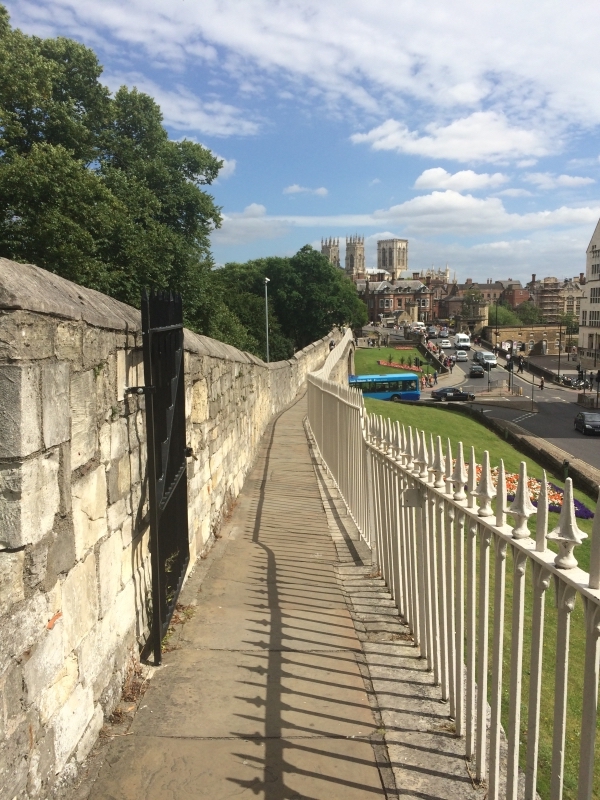A Medieval Journey To York, England
York, England is one of the most beautiful medieval cities in the world. York is charming and has retained its historical feel. It also makes for a wonderful day trip from Edinburgh. We were eager to get there while on our trip to Scotland especially since my son had studied York Minster, York's stunning Gothic Cathedral. The trip from Edinburgh to York is super easy- a 2 and half hour train ride from the Edinburgh Waverly train station located in central Edinburgh right near The Balmoral. We took an early train and arrived in York mid-morning. York is a very manageable walking city. The city center is a short walk from the train station. The first thing we saw from the train station was a spectacular view of York Minster. We couldn’t wait to explore!
York Minster
York Minster (formally called The Cathedral and Metropolitical Church of St. Peter or The Minster) is the largest Gothic Cathedral in Northern Europe. The Archbishop of York, which is the second highest office in the Church of England, is based at the Minster. It is considered both a cathedral and a minster. A minster is a church made during Anglo Saxon times as a missionary teaching church or a church attached to a monastery.
Building began in 1220 and took 250 years to complete. The Minster is known for the 128 stained glass windows that adorn the church. Walking around the outside of the Minster, you will be astounded by the architecture and amazing stone walls. We focused more on the inside which provides even more amazing sights. There are countless treasures to examine here!
The church is laid out like a cross with a nave and arms called transepts. The nave or body of the church is the widest nave in Northern Europe. Along the sides, you will see statues with missing heads. The statues have looked like this since the Reformation in the 16th century when the heads where damaged or cut off. As you walk up the nave, you will be in awe of the beauty. We were!
The King’s Screen sits at the end of the nave. This is where the entrance to the Quire, the area the choir sits in, is. This screen features 15 of the Kings of England starting with William the Conqueror and ending with Henry VI. It is very unique because of the asymmetrical placement of the kings- 8 on one side and 7 on the other. The Five Sisters Window (in the North Transept) honors the British women who lost their lives in World War I. It is the only memorial to these women in Britain. The window is actually made of grisaille glass from the mid 1200s. This type of glass is known for its grey color. The window is a stark contrast to the bright, colorful windows that are seen throughout the Minster.
East Window
The stained-glass windows wowed us. There are so many to look at and all are gorgeous. The Great East Window dates from 1405. It’s incredible to see this 600 years old window. It is the largest expanse of stained glass from the middle ages in Britain. This window covers a lot of history! The windows start with the beginning of the book of Genesis and ends with story of the second coming of Christ and the end of the world as told in the middle ages Apocalypse books.
The Great West Window dating to 1338 overlooks the western part of the nave. It has been nicknamed “The Heart of Yorkshire” because of the heart shape within the stone tracery. The window tells the story of the purpose and role of the church through its hierarchy. Legend has it that “all loved up couples to kiss under the window will stay together forever.” The window is truly beautiful. We stood looking at it for a long time!
Heart of Yorkshire in the Great West Window
Roses are included in so many aspects of decoration. From 1455-1487 a series of wars known today as “The War of the Roses” ensued. These wars pit the House of Lancaster against the House of York in a quest to claim the English throne. The white rose represents the House of York. The red rose represents the House of Lancaster. The wars ended when Henry VII (a Tudor and Lancaster) took the throne and was crowned king. He brought the Lancaster and York houses together by marrying Elizabeth of York. The Tudor rose was created by joining the white rose of York and the red rose of Lancaster. The Rose Window in the South transept commemorates both Henry’s marriage to Elizabeth as well as the end of the wars for the throne.
No trip to the Minster is complete without a trip up to the tower! Built in 1220-1253, the tower is the highest point in all of York. It is 230 feet tall with a very narrow winding staircase consisting of 275 steps. We decided to brave the stairs. At the very top the steps are extremely narrow and steep; it was like climbing a ladder. But the view from the top is breathtaking and worth the climb!
Don’t miss the mirrors near the entrance to the tower. The mirrors have been placed on tables to give visitors a better view of the ceiling without craning your neck. It’s so cool to see the ceiling images clearly and easily!
The Shambles
After visiting the Minster, we decide to wander through the medieval old town of York. The Shambles is a medieval area with a maze of twisting narrow streets. Buildings date from the late 14th century to the 15th century. There is also an actual street called “The Shambles” which today is lined with shops and tea rooms. During the Middle Ages, the buildings were actually butcher shops and the butcher’s homes. In the back of the buildings were the slaughterhouses. As you walk through the streets look for the meat hooks that are attached to some of the store fronts. When the animals were killed, they would be hung outside on the hooks. Looking closely at the ground you will notice that the sides of the cobblestone paths are at a slightly different level. This was to create a channel so that the butchers could wash the blood from the street with water twice a week. The close buildings create an overhang of sorts so that the animals were shielded from the sun. The word “shambles” actually means shelves which alludes to the shelves that existed in the open store fronts during the Middle Ages. Today, The Shambles are lined with boutiques, candy stores and cafes.
If you were to stand in The Shambles and extend both arms you’d be able to touch buildings on both sides of the path in some spots. It is so cool to wander through these narrow streets!
York Cocoa House Chocolate Cafe
York is famous for its chocolate shops. We were very excited to test one of them out. After all of our walking we were happy to take a break for a sweet treat. The York Cocoa House Chocolate Cafe located in the center of York is so yummy and worth a visit. Everything is chocolate! We decided to have afternoon tea. My son loved the hot chocolate, the chocolate croissant and scone. I settled for traditional York tea. Regular food as well as artisanal candy are available. Definitely a must stop!
The City Walls
York is surrounded by a stone wall built over 900 years ago! About 200 years ago, there was a disagreement about whether to tear the wall down or not. It was decided to leave it up and the wall has remained unchanged since then. “The Walls” or “The Bar Walls” (as the locals call it) are 3.4 kilometers long. It is the longest city wall in England. It’s possible to walk around the entire wall on the walkway. The walk takes about 2 hours to complete. One thing to know when walking on the wall. When you see the word “bar” in York that actually means a gate. The word “gate” means bar. There are four main “bars” to get onto the wall: Bootham Bar, Monk Bar, Walmgate Bar, and Mickelgate bar. In medieval times, a toll would have been paid at the bar to get onto the wall but today you can just walk on up! We decided to walk the wall until the Clifford Tower.
Clifford’s Tower, York Castle
The Clifford Tower is a 13th century tower that stands on the mound of the remains of William the Conqueror’s original York Castle. A tower, or a keep, was the central tower of a castle and traditionally a small castle within the castle having rooms, chapels and defensive qualities. William’s castle and timber tower were built in the 11th century. The tower burned down in 1190 due to religious tension between the Jewish and Christian townspeople. A group of about 150 Jewish people sought sanctuary in the Tower. When the tension increased, the Jewish townspeople realized they were surrounded. They choose to burn the tower down rather than be killed by the pressing mob.
In the 13th century, the Clifford tower was built during the reign of Henry II. It stands at 50 feet high and 200 feet wide. Originally it was called the King’s tower. In 1596, it is first recorded as being called Clifford’s Tower. Scholars are unsure if this is a reference to Roger de Clifford who was hanged at the Tower for opposing Edward II or for the Clifford Family who claimed to be hereditary constables of the tower. The tower was used as a royal mint (holding money for campaigns against the Scots) and as a prison. To reach the tower, you have to climb a very long, steep staircase. It was a workout! When you enter the tower, you may walk around the downstairs (which would have housed private apartments and a chapel). Another short climb allows you to walk around the top of the tower. We imagined what it must have been like for soldier watching for the enemy!
We were sad to get back on the train to head to Edinburgh but thrilled we had journeyed to York. For lovers of medieval history or British history, York is a must visit. The charm and character of the city is unrivaled. We truly felt like we had stepped back in time to medieval England. Wandering the Shambles and York Minster were a highlight of our trip. I know they will be for you too! Don’t forget to sample a chocolate- nothing completes a trip like a sweet treat!
Quick Links
- https://yorkminster.org/home.html
- https://www.insideyork.co.uk/index.php?q=what-to-see/shambles/
- https://www.yorkcocoahouse.co.uk
- http://www.english-heritage.org.uk/
- http://www.visityork.org
- https://www.scotrail.co.uk


















